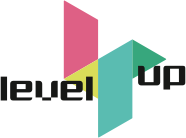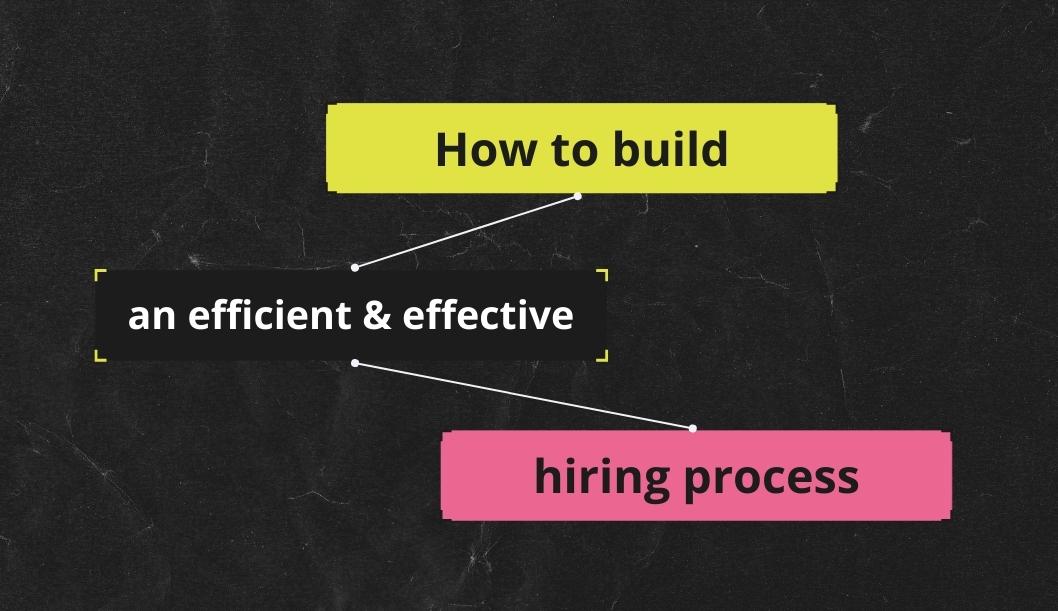Picture this: you’re hanging out with someone and they’re starting to grow on you. The conversation is flowing, and there’s just something about them that feels right. Is it too soon to ask that question? You know, the one that’s been nagging at the back of your mind: “Hey, do you want to be in a relationship with me?” I mean, it’s only been a few hours, right?
Well, believe it or not, this scenario actually plays out more often than you’d think in the realm of startups and scale-ups. That’s where founders and CxOs get swept away by their gut feelings, focusing too much on the feeling a candidate invokes in them instead of which skills are really needed to achieve their company’s mission. In dating terms, it’s like entering a marriage before you’ve even had a chance to figure out if you’re truly compatible.
So, how can startups and scale-ups avoid this impulsive hiring trap? Enter the hiring process – a step-by-step guide to help you assess candidates in a structured way which avoids any other organs dictating your decisions – except for your brain.
Stick around, and we’ll give you the lowdown on how to make this happen.
Recruiting is a two-way street: make them fall in love by being the best host ever them fall in love
When it comes to building a hiring process, it’s important to remember that hiring is a two-way street: just as you’re evaluating candidates, they’re evaluating you too. So, every interaction you have with them during this time is a chance to assess them and make them fall in love with your company’s culture and mindset.
As the interviewer, think of yourself as the host and your candidates as your guests. Your goal is to make them feel welcome and give them an unforgettable experience. And the AIDA model is your trusty map to guide you through each step of the hiring process. Whether you’re crafting a job posting, conducting an interview, or making a job offer, you want to grab their Attention, pique their Interest, create a Desire to work with your team, and prompt them to take Action.

Remember, the hiring process is all about building relationships and showing candidates what sets your company apart.
How to build an efficient & effective hiring process: alignment is key
Step #1: Start with understanding the “why”, “what” and “when” of the role
As with so many things in life, preparation is key to the hiring process – and in this case, it means having everyone who is part of it on the same page.
Why? Think of your team like a ship’s crew: you, as the captain, have a bird’s-eye view of where the ship should go and what it needs to get there. But the folks down in the engine room might have a different perspective. And if you assume everyone’s on board with your vision, you might be in for a rough sail.
Ask the entire crew the following questions:
1. Why do you want to hire somebody?
To reach an answer you need to have a look at your company’s goal, such as “Because we want to accomplish Goal 1 and Goal 2 and we lack the skills to do so ourselves”.
2. What does this person need to bring to accomplish Goal 1 and Goal 2?
If you look at what this person should bring to the team from the three perspectives – culture fit, skills, and motivation – you will come to an answer that all can agree on:
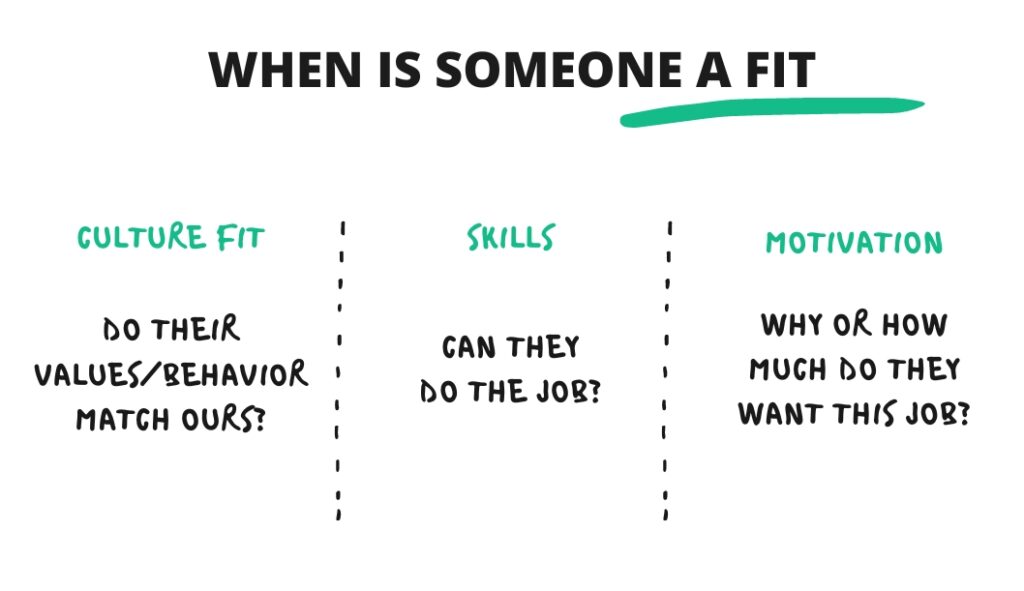
→ Culture fit: when you’re searching for a new team member, it’s important to consider whether their personality and their values align with either the rest of the team and their manager (if your team is small) or at least the departments they will work in.
Let me give you an example: if the Captain of the ship is outgoing and sociable, it might seem like a good idea to hire someone with a similar personality. But if the new crew member will be working mostly with introverted colleagues in the engine room, it might be better to find someone who can fit in with that group. Remember, a little diversity is great, but you still want everyone to feel like they’re part of the same crew!
→ Skills: The vital thing to consider is whether a potential candidate can handle the demands of the job on a daily basis. To make sure you don’t miss any essential skills, it’s crucial that all team members are on the same page about which skills the job requires. This way, everyone can agree on the qualifications needed for the new hire to hit the ground running from day one.
→ Motivation: Let’s quickly dive into candidate motivation. It’s all about understanding why a candidate wants the job and how interested they are in it. There are two types of motivation: intrinsic and extrinsic. Intrinsic motivation comes from a candidate’s desire to contribute to the world by working for a company with a great mission. Extrinsic motivation, on the other hand, might come from factors like salary. The key is to remember that a great employee can have either type of motivation. So don’t limit yourself by only looking for one or the other. Instead, think about what you can share with your candidate that will appeal to their specific motivations.
Don’t forget about the “when” – timelines
It’s the most important thing for everyone involved in the hiring process to be on the same page about how quickly they want to bring aboard the ideal candidate. If expectations aren’t clear, it can lead to disappointment and a slower overall process. If it happens that the captain wants to cruise towards new shores right away but the engine crew needs more time to prepare, expectations will not be met and people will be left disappointed which causes the boat to slow down.
I recommend you first individually answer this question and then bring everyone together. It’s easy to assume that everyone is on the same page, but when it comes down to the important details, there might be some differences.
Step #2: Prioritize your requirements – must-haves vs. nice-to-haves
Now that you have brought all hands on deck and managed to visualize the candidate’s qualities and expertise (aka cultural fit, skills, and motivation), it’s time to figure out which from this bundle of characteristics must be prioritized and which are a sweet bonus:
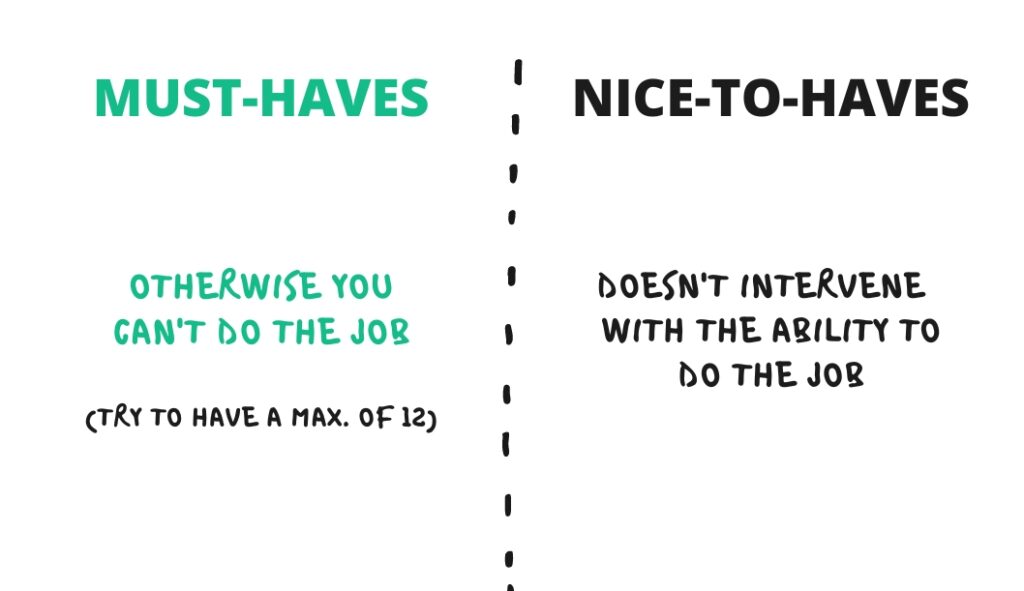
Must-Haves
There are some characteristics and qualities that are absolutely essential – without them, your candidate just won’t be able to do the job. So you must be really clear on what those must-haves are. For example, if you’re hiring a UX designer, you’ll want to make sure they have the exact expertise your company needs to solve a problem or reach your goals. Be as detailed as possible, but also keep in mind that you’ll only be able to assess around four to five must-haves per interview – and interviews usually take about an hour – so aim for around twelve.
Nice-to-Haves
These are the traits that don’t necessarily affect a candidate’s ability to do the job, but can come in handy when it comes to making a decision between candidates who are equally qualified. Maybe one candidate has experience working with a particular tool that you use, or they share a hobby with your team. So, if one candidate loves pineapple on their pizza and so does the majority of your team, that could be the tiebreaker right there! …I am kidding, of course. You do not make any major decisions based on such trivial things, but it can be helpful to have a few of these traits in mind if you cannot decide who to pick.
An additional layer to your prioritization – the golden triangle
This triangle consists of three points: money, time, and skills. And finding a candidate who hits all three is like finding a mermaid – perhaps not impossible, but definitely not a common phenomenon because you will have to spend a lot of resources before you can find someone like that. This means that one out of those three things will have to be compromised on. For instance, if you want someone to start working for you as soon as possible and at an affordable salary, chances are that their skill level won’t be as high as you wish it were. So, you must ask yourself which of these qualities of the “golden triangle” are really important before a candidate joins your ship.
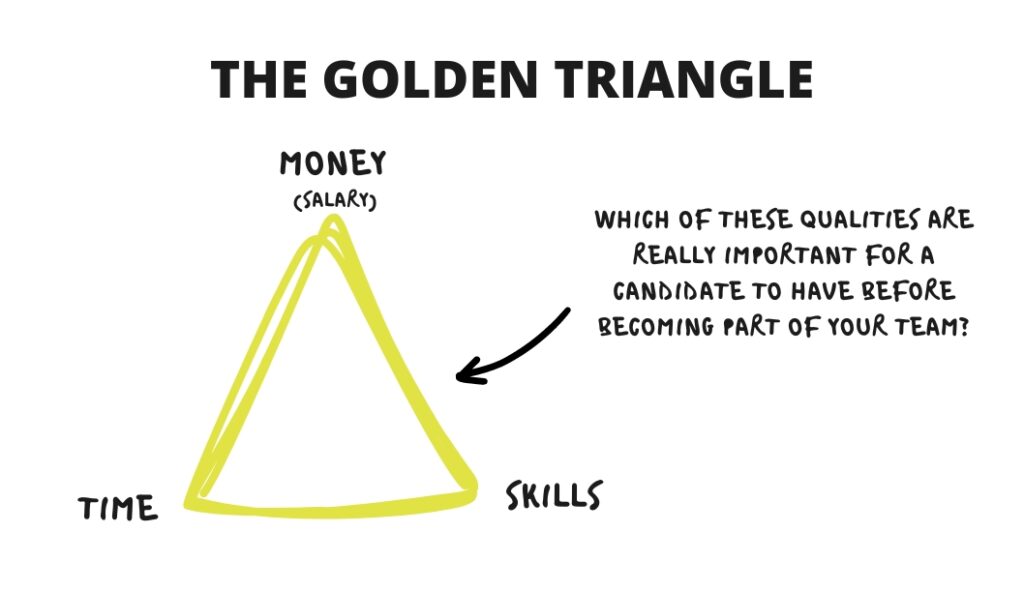
Step #3: Translate your profile into the hiring process
Great job on getting everyone on board with the qualities and aspects needed for a new team member! Now it’s time to focus on shaping the hiring process. This is where the fun begins.
Define clearly what each must-have means – so everyone speaks the same language
If you are searching for a UI Designer that is creative, there are some things to consider: they should be able to think outside of the box, be resourceful, have a vivid imagination, be original… the list goes on and on. That’s why these must-haves need to be defined together in a group so that you all use the same units of measurement when assessing a candidate.
Measuring the must-haves
Now, when you take a look at the must-haves which you decided on, you need a system on how to measure those. Ask yourselves these questions to help assess each must-have:
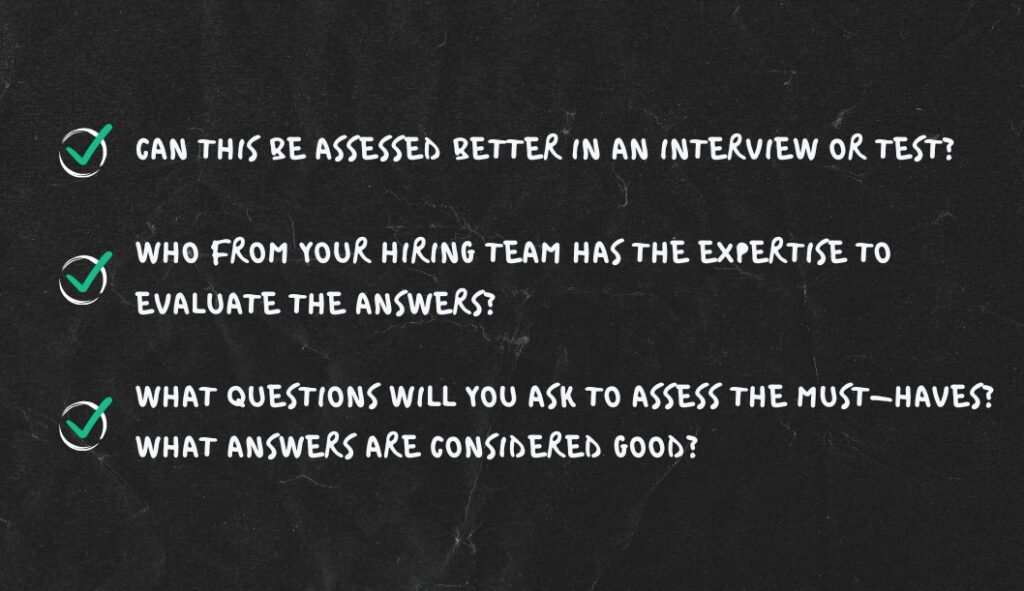
Shape the stages of your hiring process
Now that you know how you’re going to assess your must-haves, it’s time to figure out how many rounds of interviews and assignments you need. Here are some rules to keep in mind:
→ First, it’s best to keep the hiring process to a maximum of four stages. If we have too many rounds, candidates may lose interest and drop out. Plus, if they’re currently employed, they may have to take time off or lie to their current employer to attend all the interviews, which isn’t ideal.
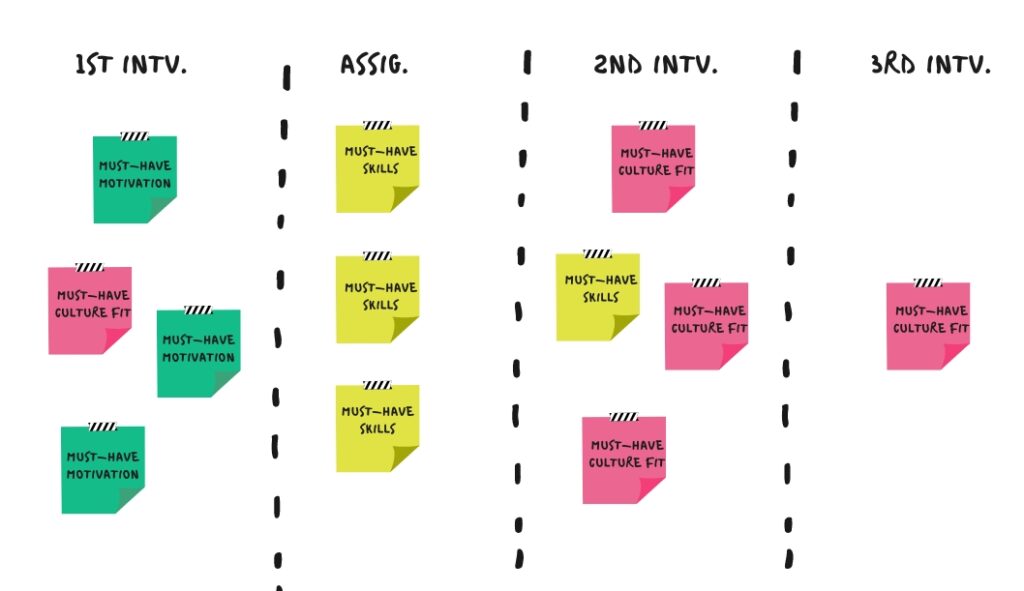
→ Second, during each interview, you don’t want to assess more than four or five must-haves. That way, you can leave enough time for follow-up questions and answers. Overall, we want to make sure our hiring process is efficient, effective, and respectful of our candidates’ time. Here’s an example of how our interview structure could look:
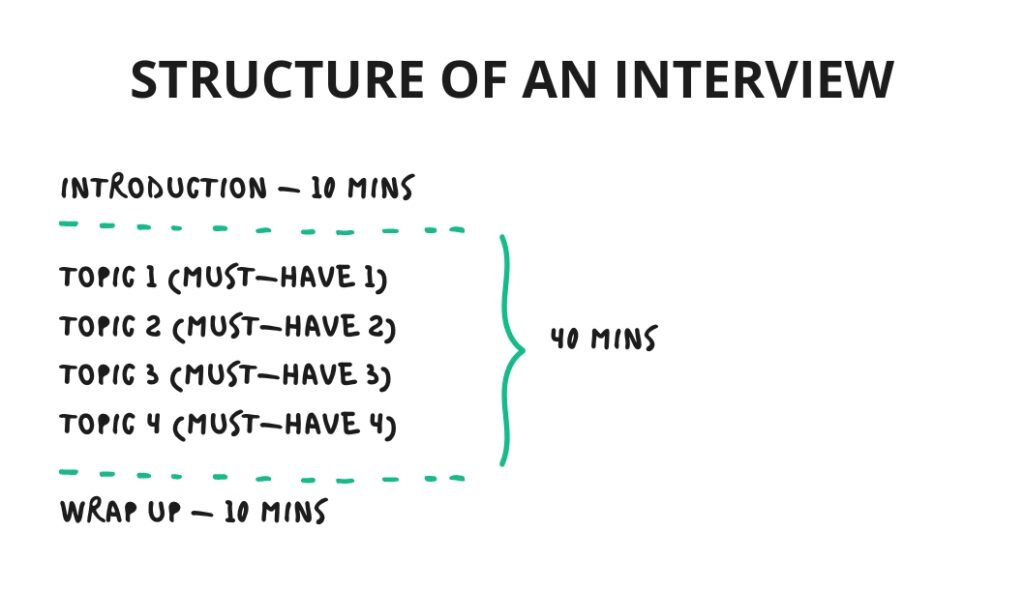
→ Make use of scorecards to keep track of everyone’s assessment and don’t share feedback on the candidate among the hiring team in-between interviews to keep the process as unbiased as possible. The interviewers in the second interview simply have to trust a candidate made it to the second round for a good reason.
Step #4: Reach the hiring decision
Alright, it’s decision time! After all the interviews and assessments, you need to ask yourself: is this the person we want to hire?
Before we make a decision, it’s important to make sure everyone on the team is on the same page. If we didn’t align well before the interviews, we might end up wasting the candidate’s time and our own. To avoid this, we need to ask ourselves some important questions. For example, have we seen all of the candidate’s skills and measured them without bias? If they lack a certain skill, do we see the potential for them to learn it quickly, and should we take the risk?
In a smaller company, the founder usually makes the final decision on hiring. But in a bigger company, it’s usually a group decision. Just remember, it’s important to have a clear protocol in place so everyone knows what to do.
Hiring is a two-way street, so make them fall in love with your company
In the world of startups and scale-ups, it’s easy to fall into the trap of impulsive hiring based on gut feelings. But you want to avoid that and make sure you have a structured hiring process in place. Preparation and alignment are key! Everyone involved in the hiring process should be on the same page when it comes to the “why,” “what,” and “when” of the role. By doing this, you can create a positive candidate experience and find the right talent. Remember, hiring is a two-way street, and you want to be the best host ever.
Edited by Sascha Gala Mikic
